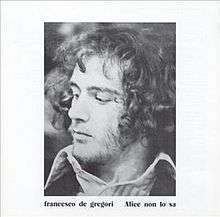Alice non lo sa
| Alice non lo sa | ||||
|---|---|---|---|---|
 | ||||
| Studio album by Francesco De Gregori | ||||
| Released | April 1973 | |||
| Studio | Studio 38, Rome | |||
| Genre | Pop | |||
| Length | 40:43 | |||
| Language | Italian | |||
| Label | It | |||
| Producer | Edoardo De Angelis[1] | |||
| Francesco De Gregori chronology | ||||
| ||||
Alice non lo sa is the debut solo album by Italian singer-songwriter Francesco De Gregori, released on April 1973 by It. The previous year the eponymous duo of De Gregori and Antonello Venditti—another Italian singer-songwriter–published a hybrid album, Theorius Campus, with some songs by De Gregori.[2]
The title track, "Alice", is one of De Gregori's best known songs, and has become a classic.[3][4][5]
Reception
The historian Cesare Grazioli writes that De Gregori became the acknowledged "prince" of songwriters, inspired by Bob Dylan, a melancholy narrative voice expressing the doubt, ambiguity and human crisis of the times, with Alice no lo sa his first album.[6] The album gained for De Gregori an undeserved reputation for being obscure.[7] The album indicated De Gregori's innovativeness: the title song, "Alice", broke with the past with its elegant lyrics and visionary quality,[8] still esteemed a generation later.[9] The album was not an immediate commercial hit, but it had great artistic value with its evocative poetry and sophisticated melodies, and it proved to be the first of a series of masterpieces of popular music.[10] Mariano Prunes, reviewing the album on AllMusic.com, notes that while only the title track is recognised as a classic, several other songs deserve to be. The album, writes Prunes, is influenced by Leonard Cohen, and "Marianna al Bivio" actually refers to Cohen's songs "Suzanne" and "So Long, Marianne", the lyrics throughout taking centre stage rather than, as was de rigueur in Italy at the time, making the singing openly personal or political.[11]
Track listing
All lyrics written by Francesco De Gregori, except where noted; all music composed by De Gregori.
| Side one | ||
|---|---|---|
| No. | Title | Length |
| 1. | "Alice" | 3:45 |
| 2. | "1940" | 4:17 |
| 3. | "Le strade di lei" | 4:16 |
| 4. | "Suonatori di flauto" | 2:08 |
| 5. | "Buonanotte fratello" | 3:54 |
| 6. | "Sono tuo" | 2:40 |
| Side two | ||
|---|---|---|
| No. | Title | Length |
| 7. | "I musicanti" | 2:08 |
| 8. | "La casa di Hilde" (De Gregori, Edoardo De Angelis) | 4:40 |
| 9. | "Il ragazzo" | 4:25 |
| 10. | "Irene" | 2:12 |
| 11. | "Marianna al bivio" | 3:02 |
| 12. | "Saigon" | 3:22 |
References
- ↑ "SERATE D'AUTORE storici e nuovi protagonisti della canzone d'autore italiana" (in Italian). Teatro Lo Spazio. Retrieved 6 February 2016.
- ↑ "Focus on Francesco De Gregori". Legacy Recordings. Retrieved 6 February 2016.
- ↑ Bezzone, Francesca (24 June 2015). "Italian music V: the 1970's". Life in Italy. Retrieved 6 February 2016.
- ↑ "Italian Songwriters: Francesco De Gregori. Alice". Music Graffiti. May 2015. Retrieved 6 February 2016.
- ↑ Stamp, Roger (23 February 2015). "La Donna Cannone, Francesco De Gregori (1983)" (in Italian). Stamp Toscana. Retrieved 6 February 2016.
- ↑ Grazioli, Cesare. "L'Italia in musica - Quarta parte La seconda generazione dei cantautori" (in Italian). La Cle des Langues. Retrieved 6 February 2016.
- ↑ Talanca, Paolo. "Dente e Vasco Brondi. Supposti ermetismi" (in Italian). L'Isola della Musica Italiana. Retrieved 6 February 2016.
- ↑ Piccolo, Antonio. "Francesco De Gregori" (in Italian). AntiwarSongs.org. Retrieved 6 February 2016.
- ↑ Bensalhia, John (27 June 2014). "'Pop' the Question - Part 3: How Did Italian Pop Music Flourish in the 1970s?". Italy Magazine. Retrieved 6 February 2016.
- ↑ "Francesco De Gregori" (in Italian). Teatro Stabile Verona. 2014.
- ↑ Prunes, Mariano. "Francesco De Gregori Alice Non Lo Sa (CD - #1160848) Review". AllMusic.com. Retrieved 6 February 2016.